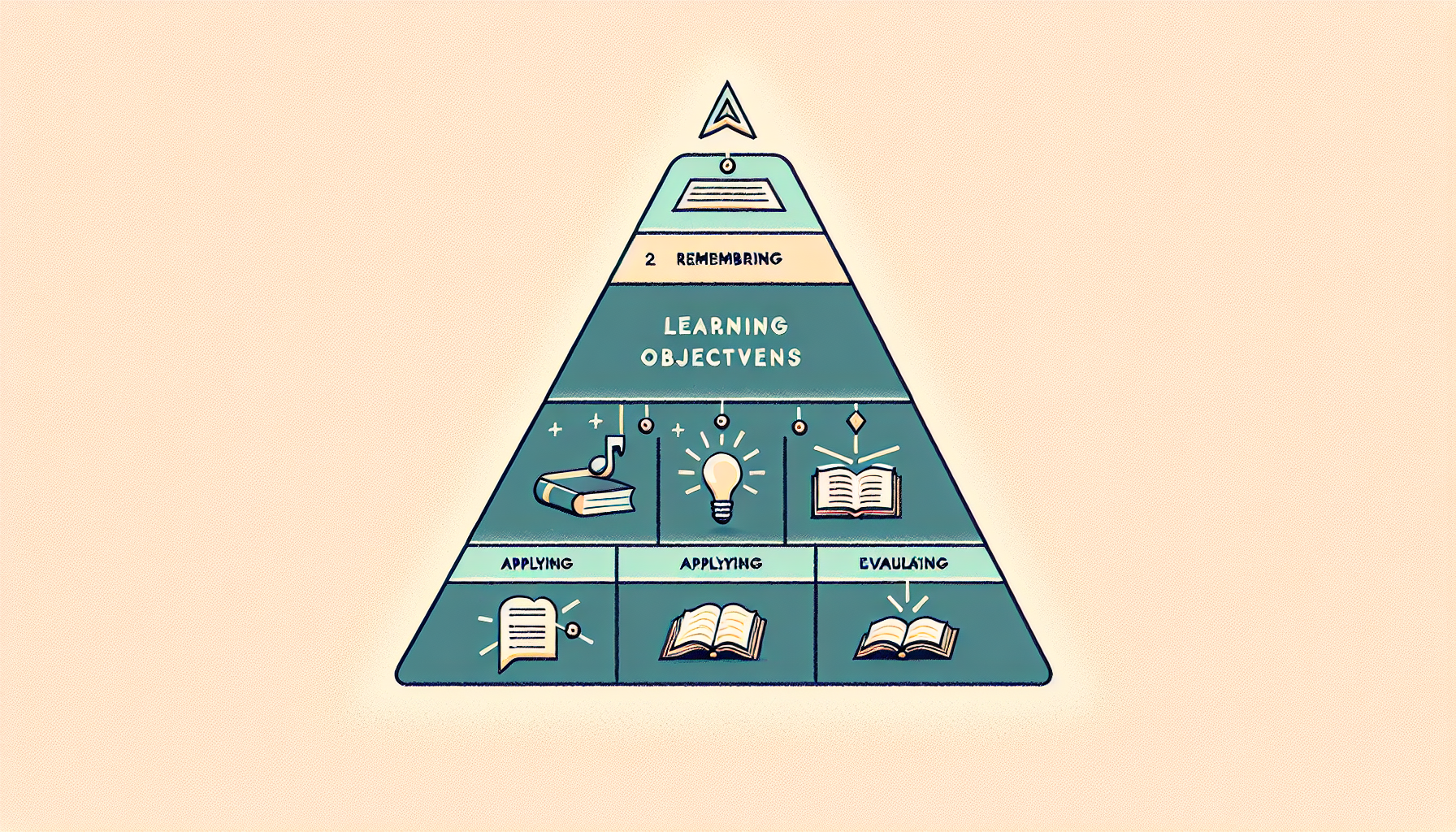Writing effective learning objectives can feel like a daunting task. You might worry about crafting statements that truly capture what you want your learners to achieve. It’s common to feel overwhelmed by the details, especially when trying to make everything clear and measurable.
But don’t fret! If you stick around, I promise you’ll find the guidance you need to create well-structured learning objectives. By the end, you’ll feel more confident in transforming your ideas into precise statements that guide your teaching and resonate with your learners.
We’ll cover key components, explore examples, and even discover how to align your objectives with assessments. Plus, you’ll learn common pitfalls to avoid. Let’s dive in and make writing learning objectives a piece of cake!
Key Takeaways
- Clearly define what learners should achieve by the end of the lesson or course.
- Use specific, measurable action verbs to indicate desired outcomes.
- Follow the SMART criteria: Specific, Measurable, Achievable, Relevant, Time-bound.
- Incorporate key components: clarity, measurability, relevance, and conditions.
- Be aware of common mistakes: avoid vague terms and ensure objectives align with assessments.
- Utilize Bloom’s Taxonomy to create objectives that progress in complexity.
- Focus on the learners’ needs to boost engagement and motivation.

How to Write Effective Learning Objectives
Writing effective learning objectives is essential for guiding both teaching and learning processes.
Start by clearly defining what you want learners to achieve by the end of a lesson or course.
Use simple, specific language to describe the expected outcomes, ensuring they are easily understood.
A good objective often starts with a verb that indicates the desired level of learning, such as “identify,” “analyze,” or “create.”
Consider using the SMART criteria, which stands for Specific, Measurable, Achievable, Relevant, and Time-bound.
For example, instead of saying “understand climate change,” you might say “explain the greenhouse effect and its impact on global temperatures.”
Always keep the learners’ needs at the forefront; this encourages engagement and motivation.
Ultimately, effective learning objectives help streamline both assessment and instruction.
Key Components of Learning Objectives
Learning objectives are like roadmaps for learners, so it’s crucial to include key components that communicate specific goals.
First, they should be clear and concise, avoiding vague terms that could lead to confusion.
Secondly, they must be measurable, allowing for assessment of whether the outcome has been achieved.
Incorporate action verbs that align with the desired level of learning; for instance, verbs like “compare,” “demonstrate,” or “design.”
Next, consider the context; objectives should be relevant to the learners’ needs and the subject matter.
Finally, include the conditions under which the learning will take place, such as “Given a dataset, learners will…”
By incorporating these components, you ensure that learning objectives not only guide but also facilitate effective instruction.
Types of Learning Objectives
Learning objectives can be broadly categorized into three types: cognitive, affective, and psychomotor.
Cognitive objectives focus on mental skills, such as understanding or problem-solving.
Affective objectives deal with emotions, attitudes, and values, aiming to influence how learners feel about a topic.
Psychomotor objectives involve physical skills and actions, such as performing a dance routine or conducting a laboratory experiment.
Depending on the course content, you may want to focus on one type more than the others, or even combine them.
For instance, a science course could include cognitive objectives for understanding theories while also incorporating psychomotor objectives for conducting experiments.
Selecting the appropriate type of objective helps clarify what learners should focus on, contributing to more effective outcomes.
Examples of Well-Written Learning Objectives
Examples can serve as great guides when crafting your own learning objectives.
For a biology course, a well-written objective might be: “Students will be able to describe the process of photosynthesis and assess its importance to life on Earth.”
This objective is clear, measurable, and directly tied to relevant content.
In a language arts class, you could have: “Learners will analyze the main themes and character development in the novel ‘To Kill a Mockingbird’ and present their findings in a group discussion.”
Here, you emphasize critical thinking and interpersonal skills, which are essential in any learning environment.
Don’t forget about affective objectives either; for instance, “Students will appreciate the significance of diversity in cultural narratives.”
This objective invites learners to engage emotionally and create connections, a vital part of the learning journey.

Common Mistakes to Avoid When Writing Learning Objectives
When writing learning objectives, it’s easy to slip into common pitfalls that can dilute their effectiveness.
One major mistake is being too vague; avoid using terms like “understand” or “know” as they don’t specify what you expect learners to demonstrate.
Another issue is neglecting to use measurable verbs. Instead of saying “students will appreciate,” opt for “students will evaluate” to provide a clear action.
Failing to consider the audience can also lead to problems. Objectives should be tailored to the specific skills and knowledge of the learners.
It’s crucial to ensure that objectives align with assessments; objectives that don’t relate to how students will be evaluated can confuse both instructors and learners.
Don’t forget to keep them realistic. Setting objectives that are too ambitious can lead to frustration, while simpler objectives may not challenge learners enough.
Taking the time to review and revise your objectives can help fine-tune them and avoid these common mistakes, ultimately leading to a more effective learning experience.
Tips for Creating Measurable Learning Objectives
Creating measurable learning objectives is all about clarity and precision.
Start by asking yourself what specific skills learners should demonstrate after the lesson.
Using [Bloom’s Taxonomy](https://createaicourse.com/what-is-lesson-preparation/) can be incredibly helpful; it outlines a hierarchy of skills from basic to advanced, guiding you in selecting appropriate action verbs.
For instance, verbs like “list,” “analyze,” or “design” help in crafting objectives that are straightforward and assessable.
Be sure to incorporate conditions that define the context; for example, “Given a case study, students will…” specifies the scenario under which learning will be demonstrated.
Another tip is to set criteria for success. Indicate how the objectives will be measured, like “with 80% accuracy” or “in a group presentation.”
Finally, keep a focus on alignments with assessments and broader curriculum goals, ensuring consistency across all areas of instruction.
By following these tips, your learning objectives will not only be actionable but also provide a clear focus for assessments.
Using Bloom’s Taxonomy in Learning Objectives
Bloom’s Taxonomy is a fantastic tool for creating effective learning objectives.
This framework categorizes learning into six levels: Remembering, Understanding, Applying, Analyzing, Evaluating, and Creating.
Starting at the base with “Remembering,” you can form foundational objectives, such as “Students will list the key components of a cell.”
As you climb the levels, you can create more complex objectives, like “Students will design an experiment to test the effects of light on plant growth,” which falls under “Creating.”
This hierarchical structure allows you to ensure a progression in learning that builds on previous knowledge.
When designing your objectives, use the verbs associated with each level, which helps keep clarity and focus.
You can even tailor lessons to address all levels of Bloom’s Taxonomy, cultivating a richer learning environment that engages different thinking skills.
Incorporating this taxonomy not only aids in developing learning objectives but also enhances student engagement by challenging them at various cognitive levels.

Aligning Learning Objectives with Assessments
Aligning your learning objectives with assessments is crucial to ensure that both teaching and evaluation are on the same page.
Start by reviewing your learning objectives and ensuring they reflect what you want students to know or do by the end of the course.
Next, design assessments that directly measure these objectives; for instance, if your objective is “analyze,” your assessments should require learners to analyze scenarios or data.
Create a matrix that maps each learning objective to specific assessments to visualize this alignment better.
Also, consider using various assessment types, like quizzes, projects, or presentations, to match different learning styles.
Don’t forget to gather feedback from assessments to tweak your objectives and ensure they remain relevant for future courses.
This ongoing alignment fosters a cohesive learning experience and clarifies expectations, making it easier for students to succeed.
Reviewing and Revising Learning Objectives
Regularly reviewing and revising your learning objectives helps keep them fresh and relevant.
Start by reflecting on past courses; gather feedback from students and assess what worked and what didn’t.
Engage with peers or attend workshops to gain fresh perspectives on your objectives.
Look for shifts in educational standards or learner needs that could impact your objectives.
Don’t be hesitant to adjust wording to make them clearer or more specific, which can enhance understanding.
Also, check if your objectives still align with your teaching strategies and assessment methods.
Finally, make reviewing a routine practice, perhaps at the end of each term, to stay proactive rather than reactive in your teaching approach.
FAQs
Learning objectives are specific, measurable statements that define what learners should achieve by the end of a course. They guide curriculum design and assessment, ensuring clarity and focus in the learning process.
To ensure measurability, use specific action verbs that describe observable outcomes. Incorporate criteria and standards, making it clear how performance will be evaluated to achieve those objectives.
Common mistakes include being overly vague, using non-measurable verbs, lacking alignment with assessments, and failing to consider learner needs. Ensuring clarity and specificity is crucial for effective learning objectives.
Bloom’s Taxonomy provides a framework for categorizing educational goals. It helps in selecting appropriate verbs for learning objectives, ensuring they range from lower-order (remembering) to higher-order (creating) cognitive skills.
